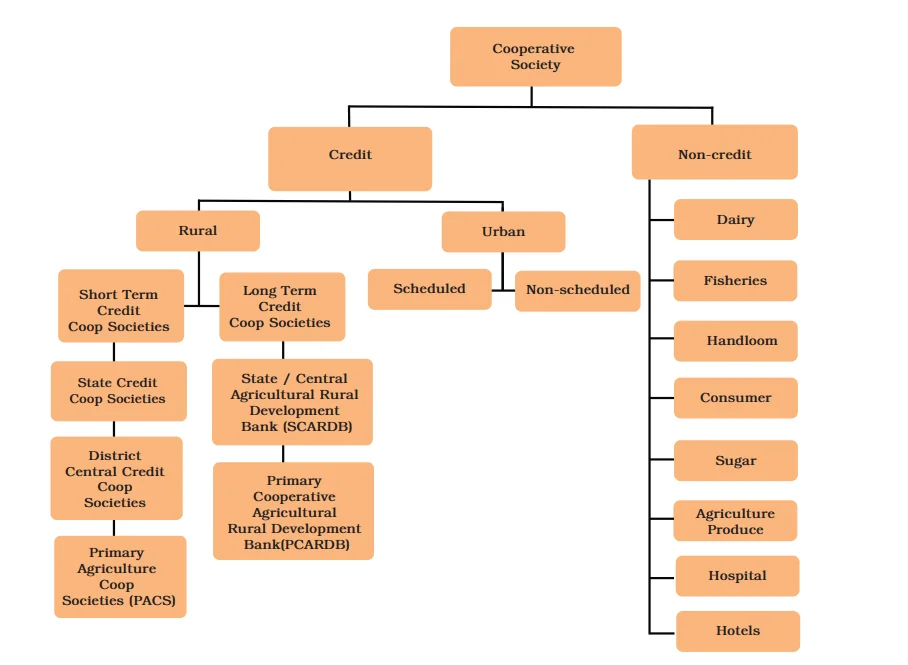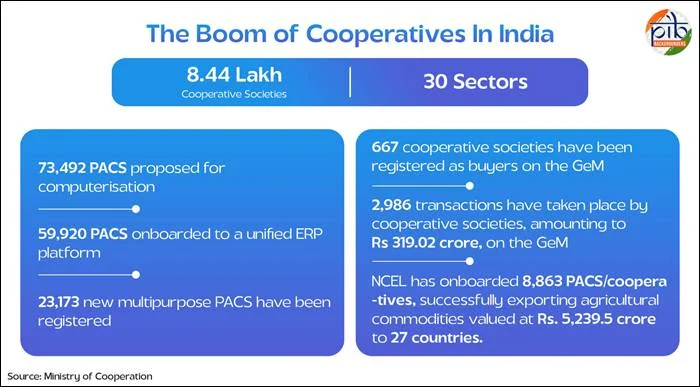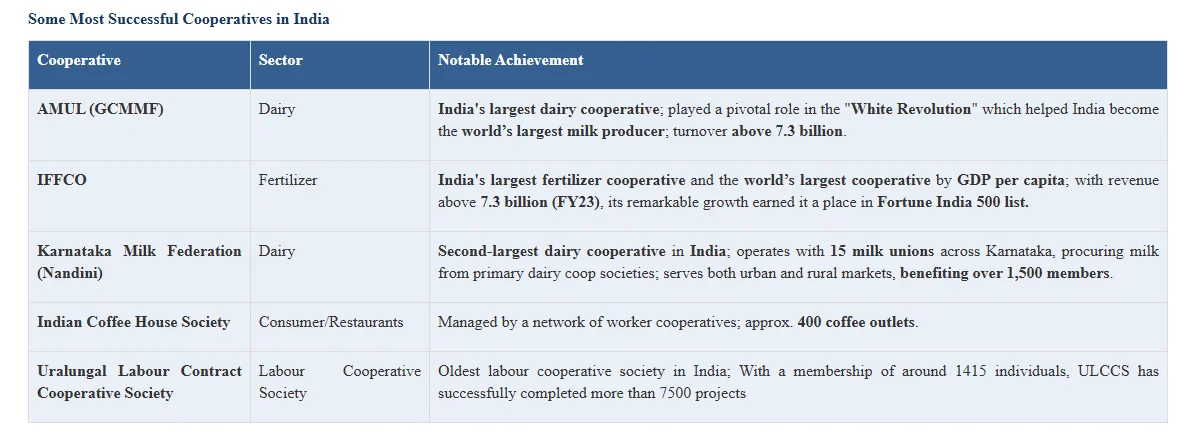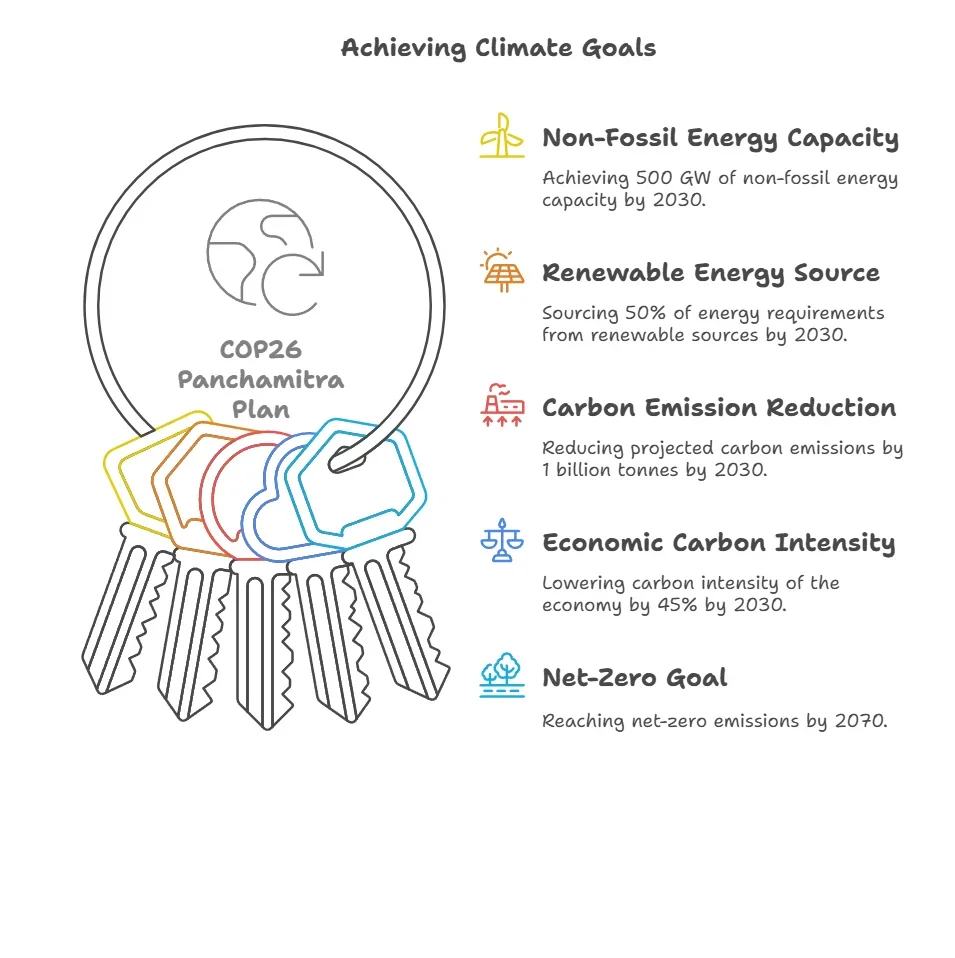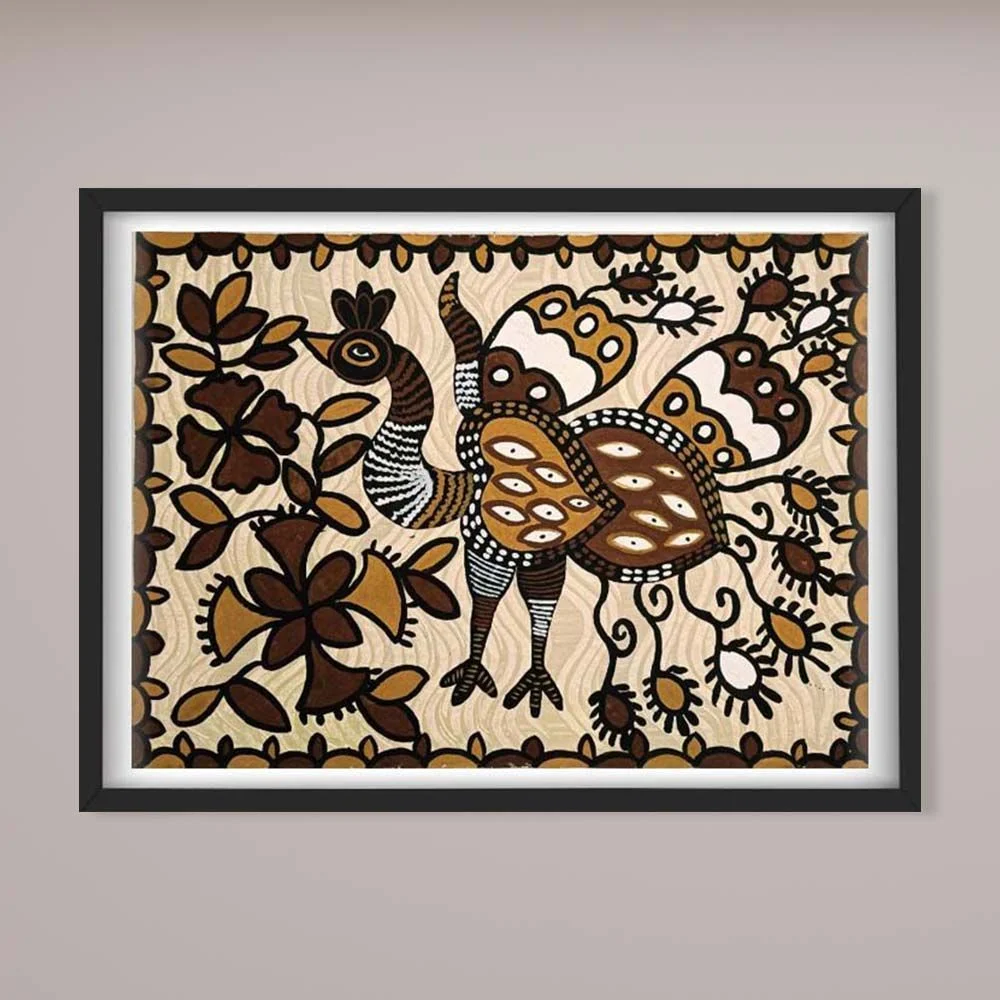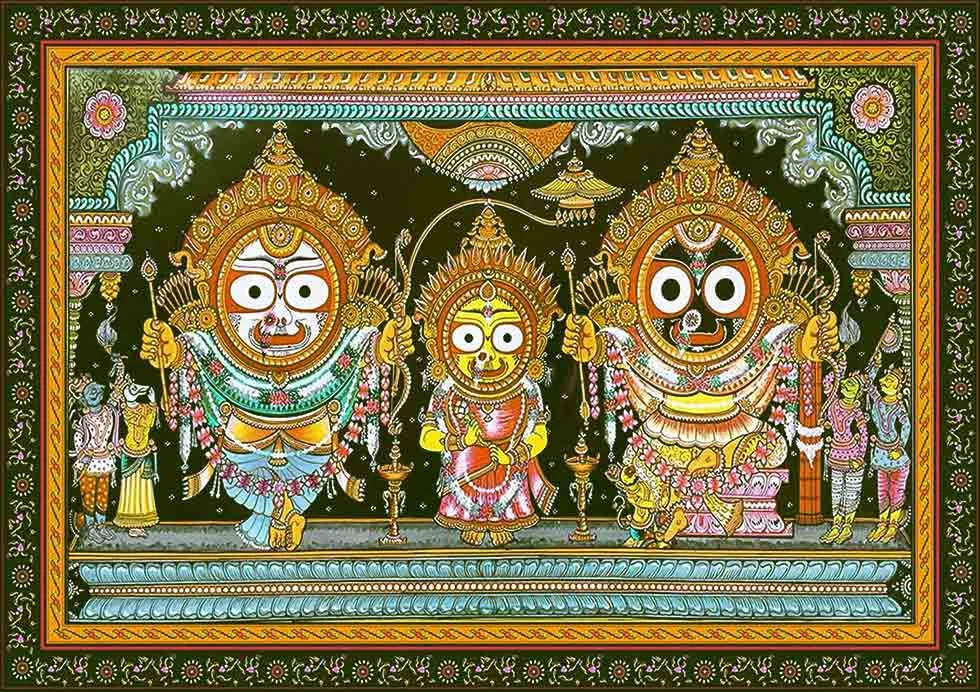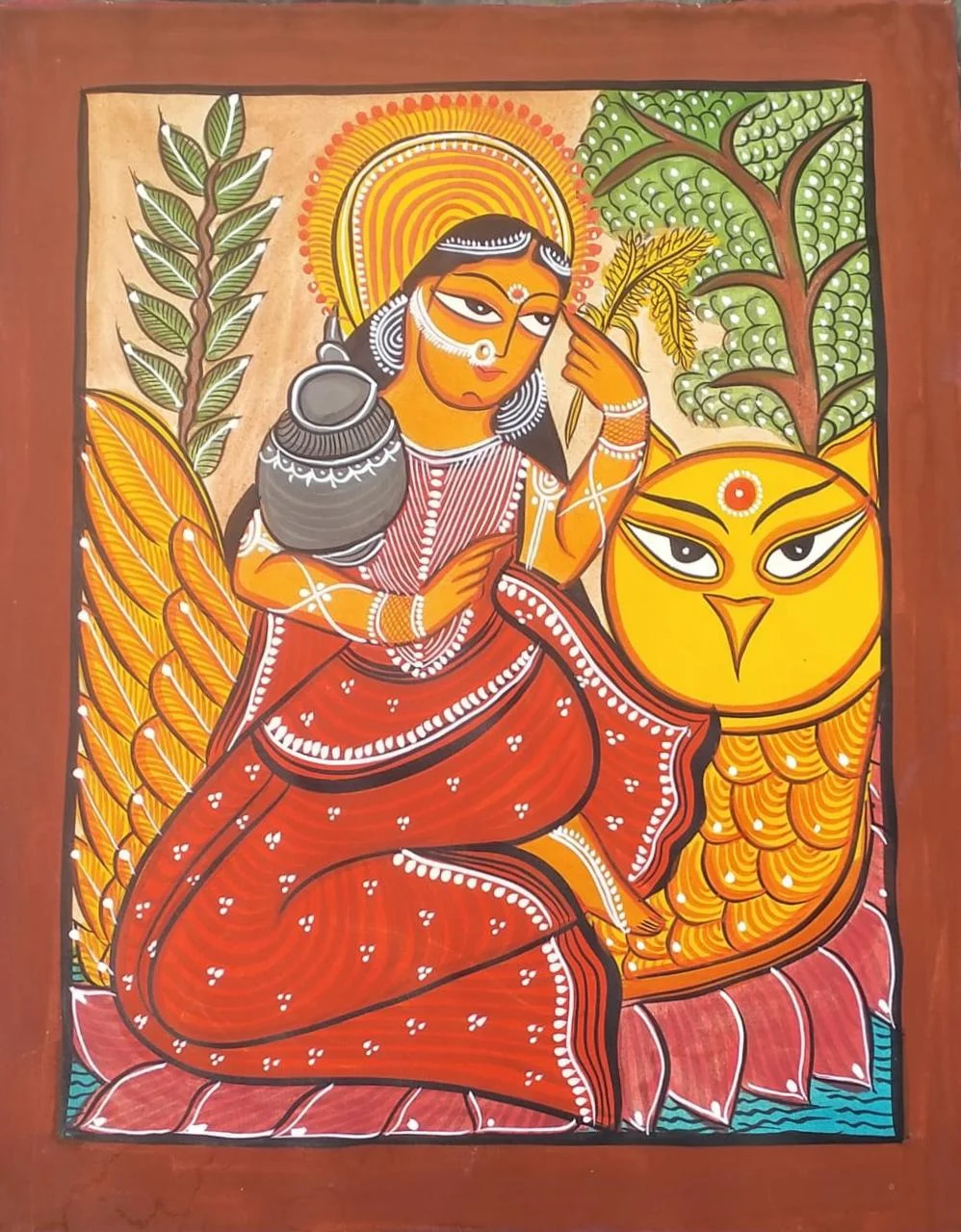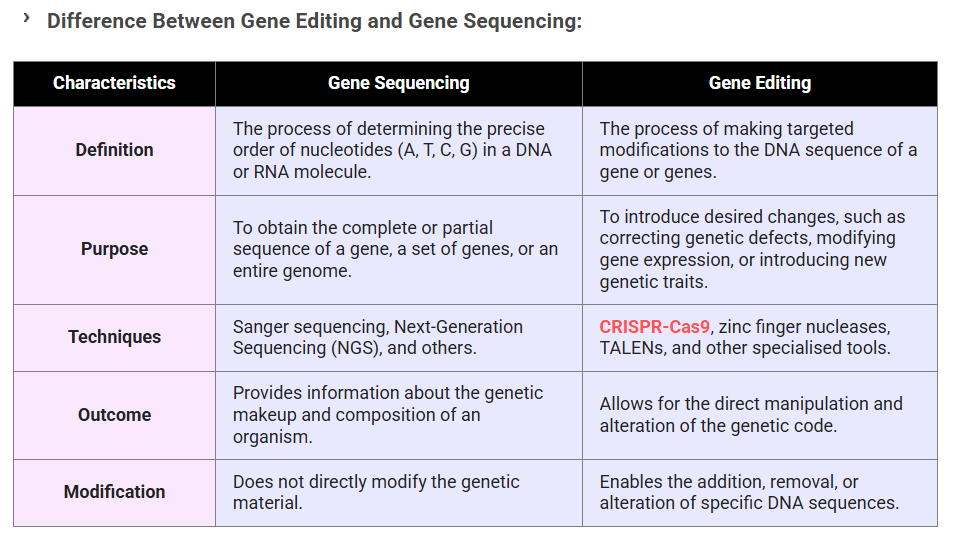National Cooperation Policy 2025
For Prelims: Cooperatives, Dairy Infrastructure Development Fund , Primary Agricultural Credit Societies, International Day of Cooperatives, Article 19
For Mains: National Cooperation Policy 2025, Evolution and role of cooperatives in India's socio-economic development
Why in News?
To mark the United Nations-designated International Year of Cooperatives (IYC) 2025, India unveiled the National Cooperation Policy 2025 to transform the cooperative sector into a people-driven economic force.
International Year of Cooperatives (IYC) 2025
- CoopsDay, or the International Day of Cooperatives, has been celebrated since 1923 and was officially recognized by the UN in 1995. It is observed on the first Saturday of July each year.
- The Committee for the Promotion and Advancement of Cooperatives (COPAC) is hosting the IYC 2025.
- Theme of IYC 2025: "Cooperatives Build a Better World", highlighting their role in inclusive, sustainable development and achieving the UN Sustainable Development Goals (SDGs) by 2030.
- Scale of Global Cooperatives:
- Over 12% of the global population is part of the 3 million cooperatives worldwide.
- Cooperatives provide jobs or work opportunities to 280 million people, about 10% of the global workforce.
- The International Cooperative Alliance (ICA) represents over 1 billion cooperative members globally.
What are the Key Features of the National Cooperation Policy 2025?
- Vision and Objective:It supports the Ministry of Cooperation’s mandate of "Sahakar se Samriddhi" by aiming to strengthen cooperatives and expand their grassroots reach.
- The policy replaces the National Policy on Cooperatives in 2002 and sets the course for cooperative growth over the next two decades (2025–2045).
- Convergence of Government Schemes: The policy aims to leverage existing government schemes such as the Dairy Infrastructure Development Fund (DIDF), PM Matsya Sampada Yojana (PMMSY), and the National Programme for Dairy Development (NPDD) to establish 2 lakh new multipurpose Primary Agricultural Credit Societies (M-PACS) within five years.
- Inclusive Growth and Employment: The policy aims to empower rural populations by making cooperatives more inclusive, focusing on Dalits, Adivasis, women, and youth, while strengthening their role in the wider economy.
- Diversification and Education: The policy pushes cooperatives to expand into over 25 sectors like dairy, fisheries, and foodgrain procurement.
- The policy promotes cooperative education via Tribhuvan Sahkari University, India’s first national cooperative university.
- Technological Advancements and Global Engagement: The policy aims to modernise cooperatives to stay competitive in a fast-changing, tech-driven world.
- The policy sets up National Cooperative Exports Limited (NCEL) to help cooperatives access global markets, focusing on exports like rice and wheat.
What are Cooperatives?
- About: A cooperative is an autonomous association of persons united voluntarily to meet their common economic, social and cultural needs, and aspirations through a jointly-owned and democratically-controlled enterprise.
- They follow the principle of "one member, one vote", giving every member equal say, regardless of capital contribution.
- In India, the cooperative movement began in the late 19th century to tackle rural debt and exploitation. Key steps included the Cooperative Acts of 1904 and 1912.
- Post-independence, cooperatives became central to India’s development, with institutions like National Bank for Agriculture and Rural Development (NABARD) and National Cooperative Development Corporation (NCDC) supporting them.
- Another development of cooperatives is the rise of cooperative banks regulated under the Banking Regulation Act, with around 1,400 Urban Cooperative Banks in India.
- Constitutional & Legal Backing: The 97th Amendment, 2011 granted cooperatives constitutional status.
- Article 19(1)(c) ensures the right to form cooperatives, while Article 43B promotes them as a Directive Principles of State Policy (DPSP).
- Part IXB (Articles 243ZH - 243ZT) provides governance provisions for Cooperatives.
- State-level cooperatives fall under the State List, while multi-state cooperatives are governed by the Union List and the Multi-State Cooperative Societies (MSCS) Act, 2002.
- The MSCS Act is administered by the Central Registrar, and state cooperatives are managed by State Registrars.
- The Ministry of Cooperation was established in 2021 by transferring cooperation-related entries from the former Ministry of Agriculture, Cooperation, and Farmers Welfare.
- MSCS (Amendment) Act, 2023 improved governance and transparency of cooperatives.
- Scale of Cooperatives in India: India has nearly 8.42 lakh cooperatives and 29 crore members (27% of the global total) . IFFCO and Amul are among the world’s top 300 cooperatives.
- Maharashtra leads with over 25% of all cooperatives, followed by Gujarat, Telangana, Madhya Pradesh, and Karnataka.
- Tribhuvandas K. Patel led the creation of Amul by organising village dairy cooperatives. Verghese Kurien, the force behind India’s White Revolution, made Amul a national success and turned India into the world’s top milk producer.
What are the Key Initiatives Undertaken by India in the Cooperative Sector?
- PACS: Model bye-laws were introduced to bring uniformity and transparency across states. This helps Primary Agricultural Credit Societies (PACS) function more efficiently and democratically.
- Farmer Producer Organisations (FPOs): As of 2025, around 1,900 FPOs formed in the cooperative sector by NCDC.
- Fish Farmer Producer Organisations (FFPOs) are being promoted to help small fishers with better resources, training, and credit.
- National Cooperative Organics Limited (NCOL) is promoting organic farming through PACS and has launched Bharat Organic products to support sustainable and chemical-free agriculture.
- White Revolution 2.0: Launched in 2024, this initiative aims to increase milk procurement by 50% over the next five years, with over 9,000 dairy cooperative societies already registered.
- Cooperative Banking Reforms: Urban cooperative banks (UCBs) are now allowed to open new branches, while rural cooperative banks can lend to commercial real estate.
- GeM portal: Cooperatives can now register as buyers on the GeM portal to ensure transparent and cost-effective procurement. As of 2024, over 550 cooperatives have been onboarded so far.
What are the Challenges and Opportunities for the Cooperative Sector in India?
Challenges
- Weak Infrastructure: In states like Uttar Pradesh and Bihar, the cooperative network remains underdeveloped. Expanding the reach of cooperatives to these states could be a logistical and financial challenge.
- Low Member Participation: Marginalised communities are underrepresented. Limited awareness and engagement reduce the strength of cooperative functioning.
- Financial Barriers: Many cooperatives, especially those serving poorer sections, struggle to get loans due to lack of collateral or proper documentation.
- Lack of Skills: Many cooperatives lack trained personnel and managerial expertise, affecting performance.
- Technological Integration: While India aims to modernize cooperatives, many societies, especially in rural areas, may face challenges in adopting and implementing new technologies.
Opportunities
- Economic Empowerment: The establishment of two lakh new M-PACS and the expansion of dairy, fishery, and other cooperative sectors offer vast economic opportunities, particularly for rural and agricultural communities.
- Increased Global Presence: The formation of the NCEL and the opening of export markets could help cooperatives gain global recognition, potentially enhancing foreign exchange earnings.
- Job Creation: With cooperatives contributing significantly to sectors like agriculture, dairy, and fisheries, the NCP 2025 can provide millions of new job opportunities, further addressing unemployment in rural areas.
- Improve Governance: Use digital platforms for financial reporting, ensure regular audits, and promote member participation.
Conclusion
Cooperatives are a grassroots movement empowering farmers, women, and small entrepreneurs. They promote inclusive growth and resilient communities. Under the National Cooperation Policy 2025, India reaffirms its commitment to “Sahkar se Samriddhi,” aiming to use cooperatives as a vehicle for sustainable development and widespread prosperity.
|
Drishti Mains Question: The cooperative model has long been a tool for rural empowerment in India. In light of the National Cooperation Policy 2025, critically evaluate how cooperatives can drive inclusive growth. |
UPSC Civil Services Examination, Previous Year Question (PYQ)
Prelims:
Q. With reference to ‘Urban Cooperative Banks’ in India, consider the following statements: (2021)
- They are supervised and regulated by local boards established by State Governments.
- They can issue equity shares and preference shares.
- They were brought under the purview of the Banking Regulation Act, 1949, through a 1966 Amendment.
Which of the above statements are correct?
(a) 1 only
(b) 2 and 3 only
(c) 1 and 3 only
(d) 1, 2 and 3
Ans: (b)
Q. In India, which of the following have the highest share in the disbursement of credit to agriculture and allied activities? (2011)
(a) Commercial Banks
(b) Cooperative Banks
(c) Regional Rural Banks
(d) Microfinance Institutions
Ans: (a)
Mains:
Q. “In the villages itself no form of credit organisation will be suitable except the cooperative society.” – All India Rural Credit Survey. Discuss this statement in the background of agricultural finance in India. What constraints and challenges do financial institutions supplying agricultural finance face? How can technology be used to better reach and serve rural clients? (2014)
Progress on India’s Climate Targets
For Prelims: Paris Agreement 2015, Carbon Sink, Monoculture, Climate Finance, Lithium-ion, Sodium-ion, Green Hydrogen, Agroforestry, Miyawaki Forests.
For Mains: India’s progress on its climate targets and challenges associated with it. Steps needed to further its climate targets.
Why in News?
India has made remarkable progress on its climate commitments under the Paris Agreement 2015, achieving one of its major targets five years ahead of schedule and nearing completion on the other two.
Note: The Paris Agreement (2015), adopted at COP21, set the goal of limiting global warming to well below 2°C, preferably 1.5°C. COP26 (Glasgow, 2021) served as a key milestone to review and enhance Nationally Determined Contributions (NDCs), reinforcing the Paris Agreement's implementation.
What is the Status of India’s Climate Commitments?
- Non-Fossil Fuel Capacity: India achieved its non-fossil fuel capacity target in 2024—five years ahead of schedule (2030)—with 242.78 GW (around 50%) of its 484.82 GW total installed capacity from non-fossil sources (solar, wind, hydro, nuclear).
- Carbon Sink: India had pledged to create an additional 2.5–3 billion tonnes of carbon sink through forests and tree cover.
- By 2021, it had already achieved 2.29 billion tonnes, and with a yearly increase of around 150 million tonnes (2017–2021), the total likely crossed 2.5 billion tonnes by 2023.
- Emissions Intensity: India pledged to reduce the emissions intensity of its GDP by 45% from 2005 levels by 2030, and had already achieved a 36% reduction by 2020.
- Despite limited recent data, current trends suggest India is on track to comfortably meet or exceed this target.
India’s Initiatives to Achieve Climate Targets
What Concerns are Associated with India’s Climate Targets?
- Capacity vs Generation Gap: India achieved 50% non-fossil installed capacity in 2024, but only 28% of electricity generated comes from non-fossil sources.
- Moreover, just approx 6% of total energy consumption is clean, as fossil fuels still dominate sectors like industry, transport, and households.
- Heavy Reliance on Solar Energy: In 2024, India set a record by installing 30 GW of renewable energy, with solar alone contributing nearly 24 GW.
- However, wind, hydro, and nuclear sectors continue to grow at a sluggish pace due to land acquisition issues, policy delays, and financial hurdles, while China is scaling up renewables ten times faster (in the past 2 years).
- India’s nuclear capacity is expected to reach just 17 GW by 2030 against 100 GW target by 2047(the Union Budget 2025-26).
- Sustainability Concerns on Carbon Sink: Concerns persist about the share of natural forests vs monoculture plantations, their ecological impact, and whether gains can be maintained amid urbanisation and land use pressures.
- Emissions Intensity Reduction: The lack of reliable emissions data after 2020 hampers efforts to monitor progress and adjust policies in real time.
- Despite being on track to meet intensity targets, continued fossil fuel dependence in key sectors could lead to rising absolute emissions without a clear roadmap for hard-to-abate industries (e.g., steel, cement).
- Climate Finance Shortfalls: India has repeatedly flagged the shortfall in climate finance and technology transfer from developed nations, despite their Paris Agreement commitments.
- Many wealthy countries have missed emission reduction targets and under-delivered on the USD 100 billion annual climate finance pledge.
What Steps can be Taken to Further India’s Climate Target Goals?
- Bridging Capacity-Generation Gap: India must scale up battery storage technologies like lithium-ion, and sodium-ion batteries to handle solar and wind intermittency.
- Additionally, modernizing transmission networks and deploying smart grids with demand-response systems is crucial for efficient renewable integration and supply-demand balancing.
- Diversifying Beyond Solar: India should fast-track wind and hydro projects by easing land and clearance hurdles and reviving stalled hydropower through better financing and community support.
- It must boost nuclear energy and promote offshore wind and green hydrogen via targeted subsidies.
- Sustainable Carbon Sink Growth: Use satellite technologies like Geographical Information System (GIS) and remote sensing to monitor deforestation and afforestation, while promoting mixed native species over monoculture for better carbon sequestration.
- Expand agroforestry and urban green cover (e.g., Miyawaki forests) and strictly penalize illegal mining and forest encroachments.
- Securing Climate Finance: India should advocate for developed countries to fulfill their commitment to providing USD 300 billion annually by 2035 in climate finance for developing nations, as agreed at UNFCCC COP29 in Baku, and stress the importance of prioritizing grants over loans for clean energy projects.
- Simultaneously, it must attract private and foreign investment through incentives, while boosting indigenous R&D and international tech collaborations in clean technologies.
Conclusion
India has made significant progress on its climate targets, achieving key milestones ahead of schedule. However, structural challenges in generation, sectoral emissions, finance, and forest sustainability persist. Addressing these will require robust policy action, financial support, and technological innovation to ensure long-term climate resilience and equitable energy transition.
|
Drishti Mains Question: India has achieved its non-fossil fuel capacity target ahead of schedule. Critically examine the challenges that still hinder a full energy transition. |
UPSC Civil Services Examination, Previous Year Question:
Prelims
Q. In the context of India’s preparation for Climate-Smart Agriculture, consider the following statements: (2021)
- The ‘Climate-Smart Village’ approach in India is a part of a project led by the Climate Change, Agriculture and Food Security (CCAFS), an international research programme.
- The project of CCAFS is carried out under Consultative Group on International Agricultural Research (CGIAR) headquartered in France.
- The International Crops Research Institute for the Semi-Arid Tropics (ICRISAT) in India is one of the CGIAR’s research centres.
Which of the statements given above are correct?
(a) 1 and 2 only
(b) 2 and 3 only
(c) 1 and 3 only
(d) 1, 2 and 3
Ans: (d)
Q. With reference to ‘Global Climate Change Alliance’, which of the following statements is/are correct? (2017)
- It is an initiative of the European Union.
- It provides technical and financial support to targeted developing countries to integrate climate change into their development policies and budgets.
- It is coordinated by World Resources Institute (WRI) and World Business Council for Sustainable Development (WBCSD).
Select the correct answer using the code given below:
(a) 1 and 2 only
(b) 3 only
(c) 2 and 3 only
(d) 1, 2 and 3
Ans: (a)
Mains
Q.1 Describe the major outcomes of the 26th session of the Conference of the Parties (COP) to the United Nations Framework Convention on Climate Change (UNFCCC). What are the commitments made by India in this conference? (2021)
Q.2 ‘Climate Change’ is a global problem. How will India be affected by climate change? How Himalayan and coastal states of India will be affected by climate change? (2017)
Sohrai, Pattachitra, and Patua Paintings
Why in News?
Artists from Jharkhand, Odisha, and West Bengal participated in the 2nd edition of Kala Utsav 2025 – 'Artists in Residence Programme' at Rashtrapati Bhavan, showcasing traditional paintings like Sohrai Khovar, Pattachitra, and Patua.
- The program honors India’s living art traditions while offering a platform for folk, tribal, and traditional artists to showcase their work.
What are the Key Facts Regarding Sohrai, Pattachitra, and Patua Paintings?
- Sohrai Painting: It is a traditional indigenous art form practiced by women from various tribal communities in the Hazaribagh region of Jharkhand, including the Kurmi, Santhal, Munda, Oraon, Agaria, and Ghatwal groups.
- Known as harvest art, it is deeply linked to agriculture and cattle domestication. The term 'Soh' or 'Soro' means to drive away, and 'Rai' refers to a stick.
- As part of the ritual, mandalas or aripan are drawn with rice gruel to welcome cattle into homes, a task performed by village women using their fingers.
- Sohrai Khovar Painting has received the Geographical Indication (GI) tag in the year 2020.
- Patta Chitra: Originating in Odisha, it is closely associated with the Jagannath Temple in Puri, where it is traditionally used to decorate the sanctum sanctorum.
- Pattachitra, painted on cloth (Pata) coated with chalk powder and tamarind seed glue, uses natural colors from vegetable, earth, and mineral sources.
- Themes include religious, mythological, and folk stories, notably Krishna Leela and Lord Jagannath.
- Without pencils or charcoal, artists start with borders and sketch directly with light red and yellow brushes, finishing with a lacquer coating for shine and water resistance.
- Patua Painting: It is a folk art tradition from West Bengal, practiced by the Patua or Chitrakar community (both Hindu and Muslim).
- Patua artisan community is also found in Bihar, Jharkhand, Odisha, and parts of Bangladesh.
- It is painted on cloth scrolls called pati or patta, backed with old sari fabric, using bamboo-goat hair brushes and vegetable dyes fixed with gum.
- It is used to narrate Mangal Katha, especially by Hindu Patuas in Kalighat and Kumartuli.
UPSC Civil Services Examination, Previous Year Questions (PYQs)
Q. The well-known painting “Bani Thani” belongs to the (2018)
(a) Bundi school
(b) Jaipur school
(c) Kangra school
(d) Kishangarh school
Ans: (d)
Q. The painting of Bodhisattva Padmapani is one of the most famous and oft-illustrated paintings at (2017)
(a) Ajanta
(b) Badami
(c) Bagh
(d) Ellora
Ans: (a)
Q. Kalamkari painting refers to
(a) a hand-painted cotton textile in South India
(b) a handmade drawing on bamboo handicrafts in North-East India
(c) a block-painted woollen cloth in Western Himalayan region of India
(d) a hand-painted decorative silk cloth in North Western India
Ans: (a)
Kargil Vijay Diwas
India celebrates Kargil Vijay Diwas every year on 26th July to honour the bravery of Indian soldiers who fought in the 1999 Kargil War.
- On 26th Kargil Vijay Diwas in 2025, the Indian Army launched three initiatives to honour soldiers’ bravery.
- These include an e-shradhanjali portal, a QR code-based audio app sharing Kargil war stories, and a new Line of Control (LoC) viewpoint at Batalik sector.
- The Kargil War began shortly after the Lahore Declaration (1999), when Pakistani troops secretly occupied strategic heights in the Kargil district, Ladakh vacated for winter.
- In response, the Indian Army launched Operation Vijay to reclaim the heights in the Kargil region of Ladakh.
- The IAF carried out Operation Safed Sagar, targeting enemy positions on rugged peaks, while the Indian Navy launched Operation Talwar to exert pressure in the Arabian Sea.
- The war was fought in challenging terrain across key areas like Tololing, Tiger Hill, Drass, and Batalik.
- The Kargil War Memorial in Dras, Ladakh was built in 2000 to honour the success of Operation Vijay.
- The National War Memorial in Delhi honours soldiers from major conflicts, including the Sino-Indian war in 1962, Indo-Pak wars in 1947, 1965, and 1971, Indian Peace Keeping Force Operations in Sri Lanka 1987-90, and the Kargil Conflict in 1999.
| Read more: Kargil Vijay Diwas |
India’s First Tribal Genome Sequencing Project
Why in News?
Gujarat has launched India’s first Tribal Genome Sequencing Project to map the genetic profile of tribal populations.
Gujarat’s Tribal Genome Sequencing Project
- Aim: It aims to identify genetic health risks like Sickle Cell Disease, Thalassemia and provide precision healthcare tailored to the needs of tribal populations.
- It seeks to bridge the gap between scientific advancements and tribal traditions, fostering a healthier future for these communities.
- Implementation: Managed by the Gujarat Biotechnology Research Centre (GBRC).
- Scope: The genomes of 2,000 individuals from tribal communities across 17 districts will be sequenced.
Genome Sequencing
- About: It is the process of determining the exact order of nucleotide bases (A, C, G, T) in an individual’s DNA.
- It reveals a person's genetic makeup, providing insights into traits, health risks, and potential disorders.
- Types:
- Whole Genome Sequencing (WGS) maps the entire DNA sequence for comprehensive genetic information.
- Partial Genome Sequencing focuses on specific genome parts.
- Targeted Gene Sequencing sequences specific genes.
- Applications:
- Helps identify disease-causing mutations, understand the genetic basis of diseases, and discover new drug targets.
- Enables personalised medicine by predicting individual responses to drugs, allowing for optimized drug selection.
- Used in crop improvement to identify genes linked to disease resistance, high yield, and better nutrition, aiding the development of improved crop varieties.
| Read more: Genome India Project |
2025 Henley Passport Index Q2
India ranks 77th in the Henley Passport Index 2025 (Q2), up from 85th in January 2025 (Q1), showing a modest but notable improvement in global mobility for Indian citizens.
- Indian passport holders now enjoy visa-free or visa-on-arrival access to 59 destinations, up from 57 in 2024. The Philippines and Sri Lanka are the two newly added visa-free destinations for Indians.
- Singapore ranks first with access to 193 destinations, followed by Japan and South Korea with 190.
- The Henley Passport Index ranks 199 passports based on visa-free access to 227 destinations, using International Air Transport Association (IATA) data and updated quarterly.
- IATA is the trade body for 300 airlines, covering 83% of global air traffic. Its headquarters is in Montreal, Canada.
| Read more: Henley Passport Index 2025 |


